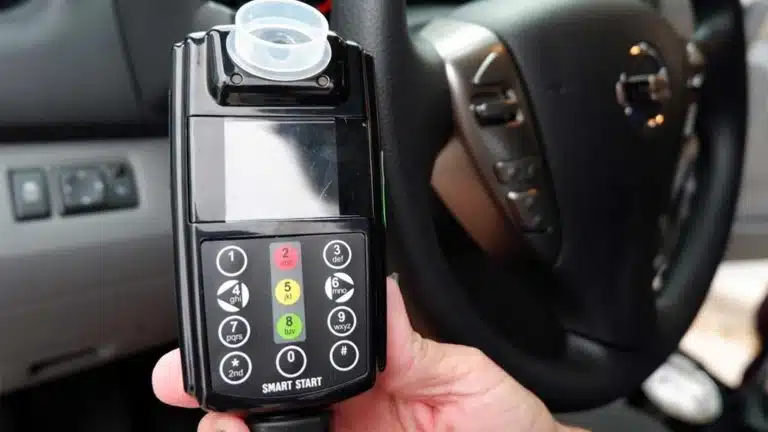Ignition Interlock Devices | What It Is, How It Works, & State Laws
- Ignition Interlock Device (IID) Overview
- Ignition Interlock Program Laws
- Installing An Ignition Interlock Device

Alcohol abuse doesn’t just impact the men and women who struggle to control their drinking. It’s also a massive public health issue that impacts everyone in a community, often with tragic consequences.
Drunk driving is a prime example because many suffering from moderate to severe alcohol use disorder (AUD) may become more and more OK with driving drunk.
Ignition interlock devices (IIDs), sometimes called breath alcohol ignition interlock devices (BAIIDs) or car breathalyzers, are one tool that law enforcement use to prevent people who have driven under the influence in the past from taking that risk again in the future.
Ignition Interlock Device (IID) Overview
An IID is a small, handheld breathalyzer device about the size of a TV remote. Most IIDs are made of the following components:
- handheld unit
- mouthpiece
- relay cord
- camera unit
How IIDs Work
Drivers must blow into the mouthpiece to provide a breath sample, which the device tests to determine a person’s breath alcohol content and, by extension, blood alcohol level.
If this is over the device’s limit it will interfere with the vehicle’s ignition system, preventing the driver from starting the car and driving drunk.
If your breath alcohol concentration is below the legal limit, you will be able to start the vehicle, but you will also be required to pass continued breath tests as the drive continues.
Interlock System Security Features
Other common security measures in place to prevent drivers from defeating a car breathalyzer system include:
- camera capture, providing evidence if a driver uses a friend’s breath to start the vehicle
- flashing lights, honking car horn, and data capture in the event a driver fails a rolling re-test during the ride
- continuous force or humming requirements, temperature sensors, and air gauges to ensure that the air entering the device is coming from a human and not a balloon or air compressor
- data capture, providing evidence in the event of IID removal or tampering by unauthorized persons
Ignition Interlock Program Laws
In December 2013, the National Highway Traffic Safety Administration published guidelines encouraging the adoption of state laws for ignition interlock systems for first-time convicted drunk drivers.
These guidelines also encouraged states to set a considerable minimum length of time in which offenders must use the interlocks.
State Laws
Today all 50 states have some sort of ignition interlock law that applies to individuals who have received a DUI or DWI depending on the circumstances of the case.
Twenty-eight states and the District of Columbia have mandatory ignition interlock provisions for all first-time offenses relating to substance abuse and motor vehicle operation.
Penalties For Refusal
If you are ordered to install an IID by a judge, court, Department of Motor Vehicles (DMV), or a probation officer, you may face serious consequences if you refuse, are found to have tampered with the device, or if you are caught using another vehicle without an IID.
These penalties may include:
- arrest
- misdemeanor charges
- license suspension or revocation
- tickets or fines
- vehicle impoundment
How Long Are Drivers Required To Use IIDs?
Drivers may be required to use an IID for six months or one year.
However, this period varies from state to state, with different periods corresponding with first-time, second-time, or third-time drunk driving offenses, low or high blood alcohol concentration (BAC), and a variety of other state-specific factors.
Installing An Ignition Interlock Device
If you are given an IID requirement you are not legally able to install the device yourself.
Instead, you’ll need to make an appointment and bring your vehicle to an interlock provider service center to have your new IID set up by a professional installer, who will make sure it’s wired in, calibrated, and working correctly.
Training & Re-Calibration
You’ll also receive either hands-on or video training on how to use the device at this time. This training is required and you will probably have to perform two or three successful breath tests before you leave.
Note that you may need to return for re-calibration services at set intervals. And, if you have a restricted license, you’ll need someone who is able to drive legally to take you to your installation appointment.
For information on our treatment programs and services, please contact us today.
Written by Ark Behavioral Health Editorial Team
©2024 Ark National Holdings, LLC. | All Rights Reserved.
This page does not provide medical advice.
Intoxalock - What are Ignition Interlock Devices and How Do They Work?
Intoxalock - What happens if I don't install an ignition interlock?
National Conference of State Legislatures (NCSL) - State Ignition Interlock Laws

Questions About Treatment?
Ark Behavioral Health offers 100% confidential substance abuse assessment and treatment placement tailored to your individual needs. Achieve long-term recovery.
100% confidential. We respect your privacy.
Prefer Texting?
Our friendly support team is here to chat 24/7. Opt out any time.







 Learn More
Learn More








